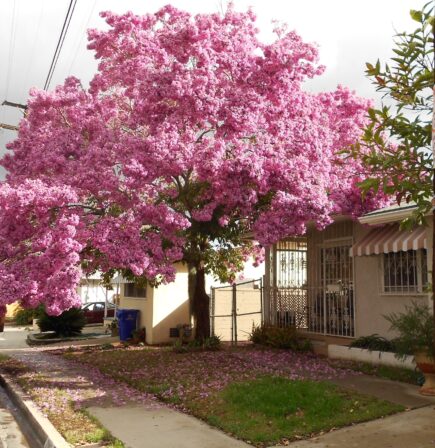Tree Envy
Walking the neighborhood is a chance to review landscape plants that I know to have healing uses. Most are imports from other parts of the world that have become popular in our gardens due to beauty and survival in our climate. This time of year, one of the treats is to see a pau d’arco (tabebuia impetignosa) tree in full bloom. My neighbors have a spectacular one that puts on a dense canopy of fuchsia-colored blossoms that emerge before the foliage, as startling and fluffy as cotton candy. In addition to enjoying a sight-seeing attraction in my local area, I have developed a deep and abiding envy and mild resentment regarding this tree. Why is theirs so successful? I want to know this 1 deposit casino uk.com.
I planted two of these pau d’arco trees into the “Trees for Health” arboretum years ago. It was anticipated that these two trees would give a blaze of color to a winter-bare garden at a time when not much else is blooming. They were placed for maximum visual impact to invite passers-by down the trail to explore. They have been nurtured with tropical rain-forest fertilizer and given extra water. Expectations have been high. If it were not for my neighbor’s tree, the disappointing, scraggly sparseness these two specimens might be blamed on their being unhappy, rain-forest imports from South America, pining for their native environment. But, it’s not so.
My neighbor’s tree denies that explanation. I am working up the courage to introduce myself and ask about their secret. I have not done so yet because I suspect they will shrug it off as some annoying leftover from a previous owner and find that they suffer its presence begrudgingly, never giving it care and certainly not knowing its value and uniqueness.
Pau d’arco, a name that roughly means “stick for making a bow,” is a phenomenal herb. The moist inner coating of the bark is harvested for its strong anti-fungal, anti-viral and anti-bacteria properties. A simmered tea made of this bark is used for any kind of infection, inside or out. It reduces the duration of colds, flu and candida yeast overgrowth. Topically, it stops infections of wounds, reduces rashes and clears up acne. It has a reputation for supporting the immune function to deal with cancer.
All this and it has a mild, enjoyable flavor, even as a therapeutic preparation of one ounce of dry herb simmered in a pint of water for 20 minutes. And, just to make it more wonderful, the bark is sustainably harvested as a by-product of the lumber industry. This hardwood is favored for use as beautiful, rich-hued floors and decks that are naturally resistant to rot and insects. All that, and it offers big blooms, too. At least, that’s the case for my neighbor’s tree.
I had carefully timed a video shoot of the garden to include the flowering of the tabeguia tree. It was supposed to be ready. Unlike my neighbor’s tree, that is in full glorious color, the ones in the arboretum are just putting on bud and not promising many of those … again this year. So the new video being posted on YouTube will feature an alternate tree, the carob. That specimen was gracious enough to produce its very first seed pod in the fifteen years since it has been planted. That made it the star of the show.
Go online to YouTube.com and enter “Trees for Health Arboretum, into the search. Look for “Amanda McQuade Crawford.” You will see, not the pau d’arco, but the cooperative and lush carob tree. And sense my lingering envy.
Category: Health & Fitness








